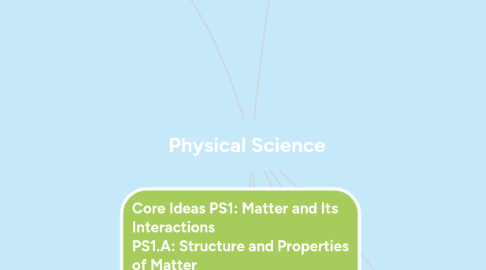Physical Science
von Damian Talos

1. Phenomena involving nuclei are important to understand, as they explain the for- mation and abundance of the elements, radioactivity, the release of energy from the sun and other stars, and the generation of nuclear power. To explain and pre- dict nuclear processes, two additional types of interactions—known as strong and weak nuclear interactions—must be introduced.
2. Grade Band Endpoints for PS1.C By the end of 8th Grade: Nuclear fusion can result in the merging of two nuclei to form a larger one, along with the release of significantly more energy per atom than any chemical process. It occurs only under conditions of extremely high temperature and pressure. Nuclear fusion taking place in the cores of stars pro- vides the energy released (as light) from those stars and produced all of the more massive atoms from primordial hydrogen. By the end of 12th Grade: Nuclear processes, including fusion, fission, and radio- active decays of unstable nuclei, involve changes in nuclear binding energies. The total number of neutrons plus protons does not change in any nuclear process. Strong and weak nuclear interactions determine nuclear stability and processes.
3. PS1.A: STRUCTURE AND PROPERTIES OF MATTER How do particles combine to form the variety of matter one observes?
3.1. The periodic table, a systematic representation of known elements, is organized horizontally by increasing atomic number and vertically by families of elements with related chemical properties.
3.2. The substructure of atoms determines how they combine and rearrange to form all of the world’s substances. Electrical attractions and repulsions between charged particles in matter explain the structure of atoms and the forces between atoms that cause them to form molecules.
3.3. Grade Band Endpoints for PS1.A By the end of 2nd Grade: Different kinds of matter exist (e.g., wood, metal, water), and many of them can be either solid or liquid, depending on temperature. By the end of 5th Grade: Matter of any type can be subdivided into particles that are too small to see, but even then the matter still exists and can be detected by other means (e.g., by weighing or by its effects on other objects).
3.4. By the end of 8th Grade: All substances are made from some 100 different types of atoms, which combine with one another in various ways. By the end of 12th Grade: Each atom has a charged substructure consisting of a nucleus, which is made of protons and neutrons, surrounded by electrons.
4. PS1.C: NUCLEAR PROCESSES What forces hold nuclei together and mediate nuclear processes?
5. Core Ideas PS1: Matter and Its Interactions PS1.A: Structure and Properties of Matter PS1.B: Chemical Reactions PS1.C: Nuclear Processes
6. Nuclear fusion is a process in which a collision of two small nuclei eventu- ally results in the formation of a single more massive nucleus with greater net binding energy and hence a release of energy. It occurs only under conditions of extremely high temperature and pressure. Nuclear fission is a process in which a massive nucleus splits into two or more smaller nuclei, which fly apart at high energy. The produced nuclei are often not stable and undergo subsequent radioactive decays.
7. PS1.B: CHEMICAL REACTIONS How do substances combine or change (react) to make new substances? How does one characterize and explain these reactions and make predictions about them?
7.1. Any chemical process involves a change in chemical bonds and the related bond energies and thus in the total chemical binding energy. This change is matched by a difference between the total kinetic energy of the set of reactant molecules before the collision and that of the set of product molecules after the collision (conservation of energy). Some reactions release energy (e.g., burning fuel in the presence of oxygen), and others require energy input (e.g., synthesis of sug- ars from carbon dioxide and water).
7.2. Understanding chemical reactions and the properties of elements is essential not only to the physical sciences but also is foundational knowledge for the life sciences and the earth and space sciences. Many substances react chemically with other substances to form new substances with different properties.
7.3. Grade Band Endpoints for PS1.B By the end of 2nd Grade: Heating or cooling a substance may cause changes that can be observed. Sometimes these changes are reversible (e.g., melting and freezing), and sometimes they are not (e.g., baking a cake, burning fuel). By the end of 5th Grade: When two or more different substances are mixed, a new substance with different properties may be formed; such occurrences depend on the substances and the temperature.
7.4. By the end of 8th Grade: Substances react chemically in characteristic ways. In a chemical process, the atoms that make up the original substances are regrouped into different molecules, and these new substances have different properties from those of the reactants. By the end of 12: Chemical processes, their rates, and whether or not ener- gy is stored or released can be understood in terms of the collisions of molecules and the rearrangements of atoms into new molecules, with consequent changes in total binding energy (i.e., the sum of all bond energies in the set of molecules) that are matched by changes in kinetic energy.


